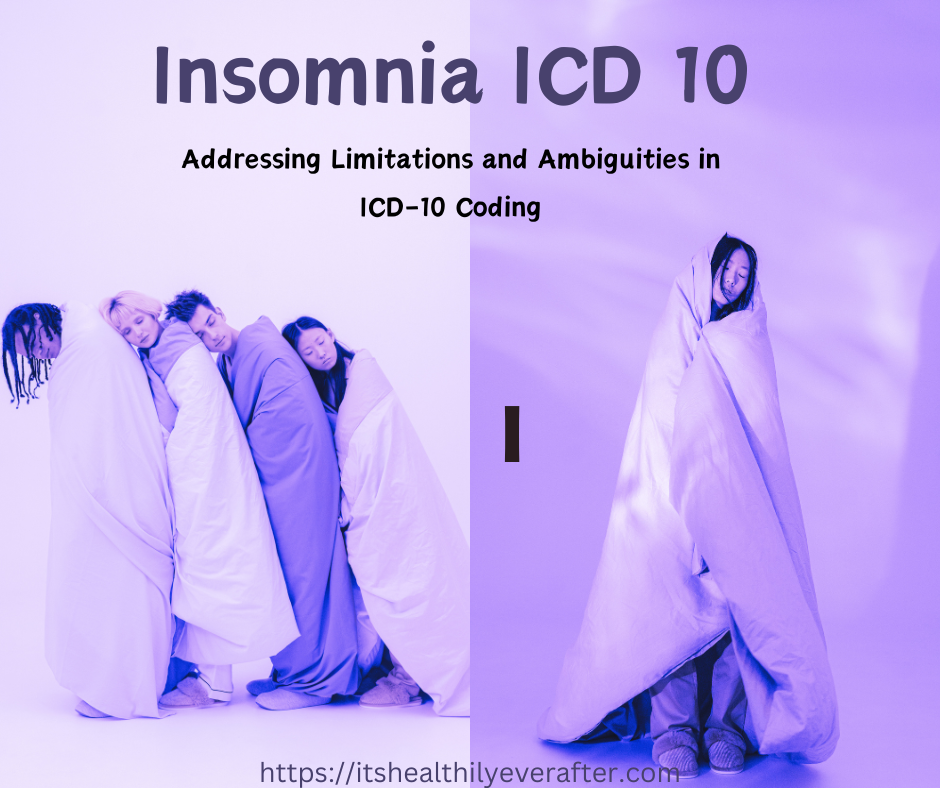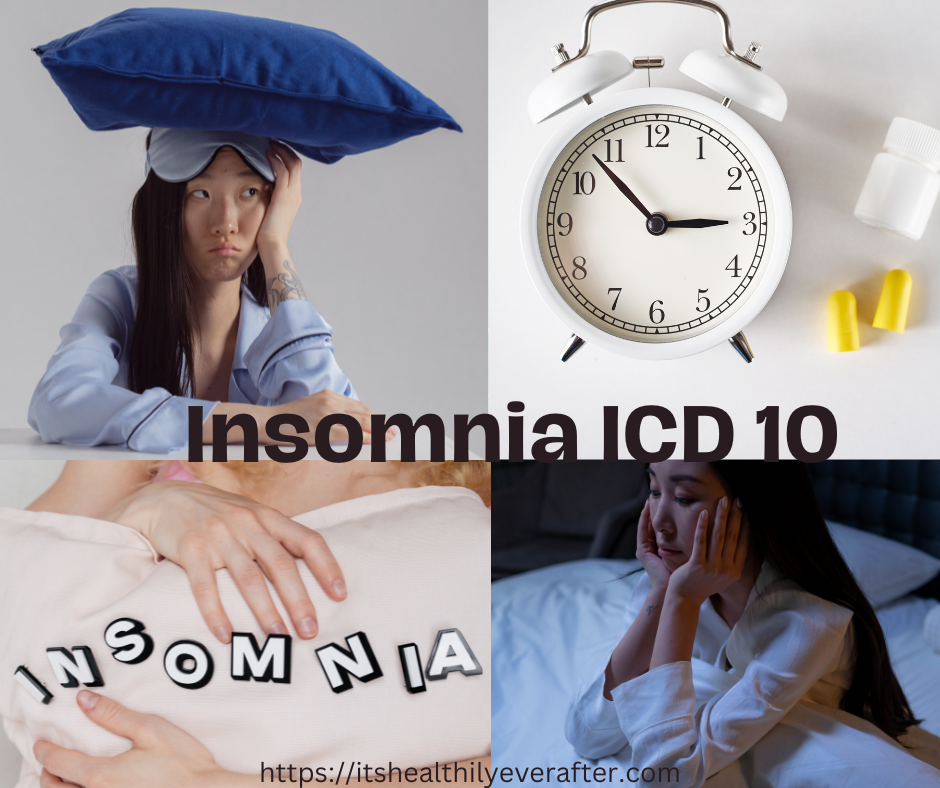Insomnia ICD 10 code: Cracking the Code unlocks the mysteries surrounding sleep disorders, particularly insomnia, through the lens of the ICD-10 classification system. Delving into the intricate world of sleep diagnostics, this guide offers comprehensive insights into the complexities of insomnia diagnosis and classification. As sleep quality profoundly impacts overall health and well-being, understanding the nuances of insomnia within the ICD-10 framework becomes increasingly vital. Join us as we unravel the diagnostic intricacies and shed light on the code that governs sleep disorders, providing valuable insights for healthcare professionals and individuals alike.
Table of Contents
Types of Sleep Disorders and their ICD-10 Codes
There are five catagories of sleep disorders:
1) Insomnia:
Insomnia is characterized by the challenge of either initiating sleep or maintaining it throughout the night, despite feeling fatigued and sleepy. It is categorized into two types: acute and chronic. Acute insomnia is a brief sleep disorder often triggered by factors like international travel or traumatic experiences. Conversely, chronic insomnia is a persistent condition lasting for a month or more. Factors contributing to insomnia include the use of specific medications, excessive alcohol consumption, nicotine use, stress, and mental health issues. The ICD-10 codes for insomnia are as follows:
- G47 Sleep Disorders
- G47.0 Insomnia
- G47.00 …… unspecified
- G47.00 …… unspecified
- G47.00 …… unspecified
2) Hypersomnia:
Contrary to insomnia, hypersomnia induces an overwhelming sensation of daytime sleepiness, even with sufficient sleep. Individuals with hypersomnia may experience multiple episodes of falling asleep during the day, potentially impacting both work and social aspects of life. Statistics suggest that hypersomnia is more prevalent in women than in men. Indications of hypersomnia encompass persistent sleepiness, morning wake-up challenges, anxiety, restlessness, headaches, hallucinations, and other related symptoms. Hypersomnia is identified through specific ICD-10 codes.
- G47.1 Hypersomnia
- G47.10 …… unspecified
- G47.11 Idiopathic hypersomnia with long sleep time
- G47.12 Idiopathic hypersomnia without long sleep time
- G47.13 Recurrent hypersomnia
- G47.14 …… due to medical condition
- G47.19 Other hypersomnia
3) Sleep Apnea:
Sleep apnea manifests when your breathing is disrupted during sleep, causing abrupt awakenings even from deep slumber. Individuals with this condition experience recurrent cessation of breathing while asleep. Failure to receive timely and appropriate treatment from a physician or neglecting the condition could contribute to additional health issues such as elevated blood pressure and an increased risk of heart attack. The ICD-10 codes associated with sleep apnea are provided below:
- G47.3 Sleep apnea
- G47.30 …… unspecified
- G47.31 Primary central sleep apnea
- G47.32 High altitude periodic breathing
- G47.33 Obstructive sleep apnea (adult) (pediatric)
- G47.34 Idiopathic sleep related nonobstructive alveolar hypoventilation
- G47.35 Congenital central alveolar hypoventilation syndrome
- G47.36 Sleep related hypoventilation in conditions classified elsewhere
- G47.37 Central sleep apnea in conditions classified elsewhere
- G47.39 Other sleep apnea
4) Narcolepsy :
This condition is known as overwhelming and unmanageable daytime sleepiness and drowsiness. Individuals with this ailment may experience sleep attacks even during daytime activities. They may also struggle to remain awake during the day. The ICD-10 codes corresponding to narcolepsy are as follows:
- G47.4 Narcolepsy and cataplexy
- G47.41 Narcolepsy
- G47.419 …… without cataplexy
- Narcolepsy in conditions classified elsewhere
- G47.421 …… with cataplexy
- G47.429 …… without cataplexy
5) Parasomnia:
This encompasses atypical and undesirable physical occurrences or experiences that disrupt sleep patterns, often happening before or during sleep. Individuals with parasomnia may exhibit abnormal movements, speech, or emotional expressions. Parasomnia manifests in two stages: non-rapid eye movement sleep and rapid eye movement sleep. The ICD-10 codes associated with parasomnia are as follows:
- G47.5 Parasomnia
- G47.50 …… unspecified
- G47.51 Confusional arousals
- G47.52 REM sleep behavior disorder
- G47.53 Recurrent isolated sleep paralysis
- G47.54 …… in conditions classified elsewhere
- G47.59 Other parasomnia

Understanding the Insomnia ICD 10 Code
Understanding the Insomnia ICD 10 Code is pivotal for healthcare professionals seeking to navigate the intricate landscape of sleep disorders. This standardized classification system provides a comprehensive framework for diagnosing and categorizing insomnia, ensuring consistency and precision in healthcare practices. Delving into the nuances of the diagnostic criteria, clinicians gain insights into the specific parameters that define and differentiate insomnia cases. Examining subtypes and severity levels further enhances their ability to tailor interventions, offering personalized care to individuals grappling with sleep difficulties. By unraveling the complexities of the Insomnia ICD 10 Code, healthcare providers empower themselves to effectively assess, diagnose, and address the diverse manifestations of insomnia, ultimately contributing to improved patient outcomes and sleep health.
i- Deciphering the Diagnostic Criteria:
Insomnia, classified under the International Classification of Diseases, 10th Revision (ICD-10), is a sleep disorder characterized by difficulty initiating or maintaining sleep, leading to impaired daytime functioning. Deciphering the diagnostic criteria entails a comprehensive evaluation of sleep patterns, duration, and associated symptoms. According to the ICD-10, insomnia is diagnosed based on specific criteria, including the frequency and duration of sleep disturbances, the impact on daily activities, and the absence of other underlying medical or psychiatric conditions contributing to sleep difficulties. Healthcare professionals rely on these standardized criteria to accurately identify and classify insomnia cases, ensuring consistency and accuracy in diagnosis across different clinical settings.
ii- Examining Subtypes and Severity Levels:
Within the realm of insomnia, the ICD-10 delineates various subtypes and severity levels to provide a more nuanced understanding of the disorder. Subtypes may include primary insomnia, characterized by sleep difficulties unrelated to other medical or psychiatric conditions, or secondary insomnia, arising from underlying health issues such as chronic pain, depression, or substance abuse.
Additionally, the insomnia ICD 10 distinguishes between acute and chronic insomnia based on the duration of symptoms, with chronic insomnia persisting for three months or longer. Severity levels further stratify insomnia based on the degree of impairment and distress experienced by the individual, ranging from mild to severe. By examining these subtypes and severity levels, clinicians can tailor interventions and treatment plans to address the specific needs and circumstances of individuals affected by insomnia, ultimately optimizing patient care and outcomes.
Diagnostic Process and Assessment Tools for Insomnia ICD 10
Navigating the diagnostic process and utilizing assessment tools is an integral aspect of comprehending the Insomnia ICD 10 Code. In this section, we explore two crucial dimensions: Screening for Insomnia and Clinical Evaluation.
i- Screening for Insomnia: Questionnaires and Assessments
Screening for insomnia involves employing specialized tools and questionnaires designed to capture relevant information about an individual’s sleep patterns, habits, and experiences. These assessments serve as valuable initial steps in identifying potential cases of insomnia, aiding healthcare professionals in the diagnostic journey. By incorporating standardized questionnaires, clinicians can gather detailed insights into sleep quality, duration, and associated symptoms, contributing to a more accurate assessment aligned with the Insomnia ICD 10 Code.
ii. Clinical Evaluation and Differential Diagnosis
Clinical evaluation plays a pivotal role in the diagnostic process, allowing healthcare providers to conduct a comprehensive examination of a patient’s medical history, sleep patterns, and overall health. This step is essential for differentiating insomnia from other sleep disorders and medical conditions, ensuring a precise diagnosis aligned with the Insomnia ICD 10 Code. By employing a thorough clinical evaluation and engaging in a process of differential diagnosis, clinicians can pinpoint the specific subtype and severity level of insomnia, facilitating tailored interventions and targeted therapeutic approaches for optimal patient care.
Coding Insomnia ICD 10: Practical Applications
Coding insomnia within the framework of the ICD-10 system requires a nuanced understanding of the code structure and effective documentation practices. This section delves into the practical applications of coding insomnia for healthcare professionals.
i- Navigating the ICD-10 Code Structure
Understanding the structure of the ICD-10 code system is crucial for accurate and efficient coding of insomnia cases. This includes familiarity with the alphanumeric structure, categories, and subcategories relevant to insomnia. By navigating this intricate coding system, healthcare professionals can precisely identify the codes associated with different insomnia subtypes, contributing to standardized and comprehensive documentation aligned with the Insomnia ICD 10 Code.
ii- Documenting Insomnia Cases Effectively
Effective documentation is essential for conveying the nuances of insomnia cases and ensuring proper coding. This involves thorough and detailed recording of patient information, diagnostic findings, and treatment plans. Adequate documentation not only facilitates precise coding but also serves as a valuable resource for collaborative healthcare efforts. In this sub-section, we explore best practices for documenting insomnia cases, emphasizing the importance of clarity, specificity, and completeness in medical records for optimal patient care and accurate coding under the Insomnia ICD 10 classification.
Clinical Considerations and Treatment Implications of Insomnia ICD 10
Understanding the clinical implications of insomnia codes within the ICD-10 framework is essential for guiding treatment strategies and optimizing patient care. This section explores the clinical considerations and treatment implications associated with insomnia ICD 10 coding.
i- Interpreting Insomnia Codes in Clinical Practice
Interpreting insomnia codes in clinical practice involves translating diagnostic information into actionable insights for patient management. Healthcare professionals must interpret the assigned ICD-10 codes within the context of each patient’s clinical presentation, comorbidities, and individualized needs. By leveraging the specificity of insomnia codes, clinicians can accurately characterize the nature, severity, and chronicity of sleep disturbances, facilitating targeted interventions and personalized treatment plans tailored to address the underlying factors contributing to insomnia.
Insomnia is characterized by difficulties in both falling asleep and staying asleep. Individuals experiencing this sleep disorder may find it challenging to initiate sleep or obtain sufficient rest throughout the night. As a result, they may endure periods of wakefulness, experience fragmented sleep, or struggle with early awakenings, leading to feelings of fatigue upon waking. Symptoms commonly associated with insomnia encompass prolonged periods of lying awake before falling asleep, short sleep durations, extended periods of wakefulness during the night, a sense of not having slept adequately, and premature awakenings in the morning.
ii- Tailoring Treatment Plans Based on ICD-10 Coding
Tailoring treatment plans based on ICD-10 coding involves aligning therapeutic interventions with the identified insomnia subtype, severity level, and underlying etiology. Healthcare providers utilize the diagnostic information encoded in the ICD-10 system to guide the selection of evidence-based interventions, ranging from behavioral and cognitive therapies to pharmacological interventions and complementary modalities.
The diagnosis of insomnia typically relies on an evaluation of the individual’s medical and sleep histories, along with a comprehensive physical examination. In some cases, a sleep study may be recommended to assess the quality of sleep and detect any underlying sleep disturbances. Treatment strategies for insomnia often encompass lifestyle modifications, therapeutic counseling, and the use of pharmacological interventions aimed at improving sleep quality and duration.
By tailoring treatment plans to the specific coding parameters outlined in the Insomnia ICD 10 classification, clinicians can optimize treatment efficacy, improve patient outcomes, and enhance overall sleep health. This sub-section explores the clinical considerations and treatment implications associated with interpreting insomnia codes in clinical practice and tailoring treatment plans based on the insights derived from ICD-10 coding.

Challenges and Future Directions
Insomnia diagnosis and classification under the ICD-10 coding system have undoubtedly provided a structured framework for understanding sleep disorders. However, like any system, it comes with its set of challenges and areas for improvement.
i- Addressing Limitations and Ambiguities in ICD-10 Coding
Despite its utility, the ICD-10 classification system may exhibit limitations and ambiguities when applied to insomnia. These can include issues with diagnostic accuracy, classification of subtypes, and discrepancies in coding practices across healthcare settings. Addressing these limitations is crucial for ensuring consistency and precision in diagnosing and managing insomnia cases.
ii- Emerging Trends in Insomnia Diagnosis and Classification:
As research continues to evolve, emerging trends in insomnia diagnosis and classification offer promise for refining our understanding of this complex disorder. From advancements in sleep monitoring technology to novel biomarkers and diagnostic criteria, the field is constantly evolving. By staying abreast of these developments, healthcare professionals can better adapt their practices to meet the evolving needs of patients with insomnia.
As we navigate these challenges and embrace emerging trends, the future of insomnia diagnosis and classification holds the potential for more accurate, individualized, and effective approaches to managing this prevalent sleep disorder.

Unveiling Real-World Applications of Insomnia ICD-10 Coding
In the realm of healthcare, the application of diagnostic codes plays a pivotal role in accurately documenting patient conditions, facilitating communication among healthcare providers, and ensuring proper reimbursement. Among these codes, the ICD-10 classification system stands out as a cornerstone in accurately representing various medical conditions. Within this system, insomnia, a prevalent sleep disorder affecting millions worldwide, holds significance in both clinical practice and medical coding. In this article, we delve into the real-world applications of insomnia ICD 10 coding through insightful case studies and illustrative examples, shedding light on coding scenarios, case analyses, and associated challenges.
i- Illustrating Insomnia Coding Scenarios
Insomnia, characterized by difficulty falling asleep, staying asleep, or experiencing non-restorative sleep, presents diverse coding scenarios within the ICD-10 framework. Consider a case where a patient presents with chronic insomnia due to underlying psychiatric conditions such as anxiety or depression. Here, the appropriate ICD-10 code would reflect both the primary psychiatric disorder and the secondary insomnia. For instance, the code F41.9 (Anxiety disorder, unspecified) combined with G47.00 (Insomnia, unspecified) would comprehensively capture the patient’s condition.
Furthermore, insomnia coding extends beyond primary diagnoses to encompass secondary diagnoses, comorbidities, and even treatment-related complications. For instance, in cases where insomnia arises as a side effect of medication, capturing this relationship through additional codes (e.g., Z79.899 – Other long-term (current) drug therapy) becomes imperative for comprehensive documentation and effective patient management.
ii- Analyzing Case Examples and Coding Challenges
Real-world case examples offer valuable insights into the complexities of insomnia ICD 10 coding and the challenges encountered by healthcare providers. Consider a patient presenting with a history of chronic insomnia exacerbated by recent life stressors. While the primary focus might be on addressing the underlying psychological stressors, accurate coding necessitates capturing insomnia as a distinct and coexisting condition, ensuring holistic patient care and accurate billing.
Challenges often arise in coding scenarios where insomnia manifests as a symptom of underlying medical conditions such as chronic pain syndromes or neurological disorders. Here, clinicians navigate the intricate landscape of coding guidelines to accurately represent the multifaceted nature of the patient’s presentation. Moreover, ensuring documentation integrity and specificity poses ongoing challenges, particularly in differentiating between transient, acute, and chronic forms of insomnia within the coding framework.
Resources and References
Delving into the world of insomnia diagnosis and ICD-10 coding is enhanced by tapping into a wealth of valuable resources. These tools, guidelines, and references serve as pillars of knowledge for healthcare professionals seeking to navigate the complexities of insomnia classification.
i- Useful Tools, Guidelines, and Resources for Insomnia Coding
In the journey to master insomnia coding, healthcare practitioners can leverage various tools and guidelines designed to streamline the process. This includes specialized coding software, comprehensive guidelines from healthcare organizations, and insightful resources that provide practical insights into effective coding practices. Accessing these tools ensures a more efficient and accurate approach to incorporating ICD-10 codes into insomnia diagnoses.
ii- References and Further Reading for Deeper Exploration
For those looking to deepen their understanding of insomnia ICD 10 coding, a curated list of references serves as an invaluable asset. Research articles, authoritative publications, and authoritative textbooks provide a comprehensive exploration of the nuances and intricacies involved in insomnia classification. By delving into these resources, healthcare professionals can enhance their expertise and stay abreast of the latest developments in the field.
By utilizing these resources and references, healthcare practitioners can elevate their proficiency in insomnia coding, ultimately contributing to enhanced patient care and accurate representation of sleep disorders within the healthcare landscape.
FAQs Insomnia ICD 10
- What is ICD-10, and how does it relate to insomnia?
- Insomnia ICD-10 is a coding system used to classify and document various health conditions, including insomnia, providing a standardized language for healthcare communication.
- Which code is commonly used for insomnia in the ICD-10 system?
- The primary code for insomnia is F51.0, indicating difficulty falling asleep or maintaining sleep, leading to significant distress and impairment.
- Are there specific codes for different types of insomnia?
- ICD-10 incorporates subcodes under F51.0 to distinguish between different insomnia types, such as transient, acute, or chronic insomnia.
- How does the ICD-10 coding process impact insomnia diagnosis?
- ICD-10 coding ensures a systematic approach to documenting insomnia cases, aiding healthcare providers in accurate diagnosis, treatment planning, and statistical analysis.
- Can insomnia be coded alongside other sleep disorders in the ICD-10 system?
- Yes, ICD-10 allows for multiple codes to be assigned, enabling the simultaneous documentation of insomnia and other coexisting sleep disorders.
- What is the significance of accurate ICD-10 coding for insomnia in healthcare?
- Accurate coding is crucial for proper reimbursement, epidemiological studies, and enhancing communication among healthcare professionals, ensuring optimal patient care.
- How can healthcare practitioners stay updated on changes to the ICD-10 coding system?
- Regularly consulting official ICD-10 updates from health organizations and attending relevant training programs helps practitioners stay informed about coding changes.
- Is the ICD-10 code for insomnia used only in sleep medicine?
- No, insomnia coding is applied across various medical specialties, reflecting its relevance in understanding and addressing sleep-related issues.
- Are there additional coding considerations for insomnia in pediatric patients?
- Pediatric insomnia has specific codes within the ICD-10 system, allowing for accurate representation of sleep disorders in children.
- What role does the ICD-10 system play in research related to insomnia?
- ICD-10 codes facilitate research by providing a standardized framework for classifying and analyzing insomnia cases, contributing to advancements in sleep medicine and treatment strategies.





Pingback: How Insomnia Wreaks Havoc On Your Mental Health | HEALTHILY EVER AFTER
Feel free to let me know if you need further assistance or if there’s anything else you’d like to add or modify!
“Hello there! I recently noticed that you’ve taken the time to visit my website, and I wanted to express my gratitude by returning the favor. As I’m constantly seeking ways to improve my site, I believe it would be beneficial to incorporate some of your ideas into my design and content strategy. Your input would be greatly appreciated, and I’m open to any suggestions you may have. Thank you for your interest, and I look forward to hearing from you!”
Sure, please email us the details thanks
“Hello there! I recently noticed that you’ve taken the time to visit my website, and I wanted to express my heartfelt gratitude for your interest. Your support means a lot to me. In return, I would like to extend my support by visiting your website as well.
“Hello there! I recently noticed that you’ve taken the time to visit my website, and I wanted to express my heartfelt gratitude for your interest. Your support means a lot to me. In return, I would like to extend my support by visiting your website as well.
I recently noticed that you’ve taken the time to visit my website, and I wanted to express my heartfelt gratitude for your interest. Your support means a lot to me, and I’m truly grateful for your visit.
You’re welcome! I appreciate your willingness to engage further. If you have any specific questions or topics you’d like to delve into, feel free to share them. Whether it’s about recent developments in technology, intriguing scientific discoveries, captivating literature, or anything else on your mind, I’m here to provide insights and assistance. Simply let me know how I can help, and I’ll be happy to assist you further!
Thank you for your response! I’m grateful for your willingness to engage in discussions. If there’s anything specific you’d like to explore or if you have any questions, please feel free to share them. Whether it’s about emerging trends in technology, recent breakthroughs in science, intriguing literary analyses, or any other topic, I’m here to assist you. Just let me know how I can be of help, and I’ll do my best to provide valuable insights and information!
What a fantastic resource! The articles are meticulously crafted, offering a perfect balance of depth and accessibility. I always walk away having gained new understanding. My sincere appreciation to the team behind this outstanding website.